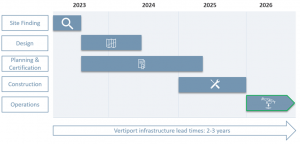
Yun-Yuan Tay is the Head of APAC for global Advanced Air Mobility (AAM) infrastructure developer, Skyports.
Big figures surrounding the Advanced Air Mobility (AAM) industry have increasingly dominated headlines over the last year, painting a picture that is bound to impress. Yet many complexities regarding the reality of getting AAM off the ground have yet to be solved for Australia.
Globally, new investments amounting to USD7 billion poured into the industry in 2021, more than double the total investment secured by the industry in the last decade. Five AAM companies went public with a combined market capitalisation of USD10.7 billion. Demand spiked in tandem, signalling increased engagement from a variety of players, as aircraft orders placed totalled 6,850, worth US$26.1 billion[1].
Activity across the global AAM market is reaching fever pitch. Today, it is no longer a matter of “if” this will happen, but “when”. For the Australian market, AAM could unlock a whole host of applications for logistics, disaster relief, medical evacuations, surveillance and security operations, as well as overland and water transport. The industry has moved beyond renderings and conceptualisation, towards real-world deployment that connects users with the technology.
The next two years will be pivotal for the industry, with the first global commercial launch targeted for 2024. Infrastructure developers must put theory to practice, and move ahead with actual operations at least on a small scale if we are ever to meet that target.
This achievement will not be reached alone, but through encouraging a highly collaborative ecosystem which brings together many AAM specialisms. Vertiport infrastructure will form the foundations of this ecosystem, acting as the link between industry, traditional aviation players and the general public.
It is easy to get swept up by the allure of stylised artist’s impressions depicting vertiports and the future of travel. However, such “fan art” purely serves marketing objectives, falling short of meeting practical operational needs. Without creating a carefully studied and rigorously tested vertiport network, these isolated nodes will be impractical, potentially unsafe, and effectively preclude the robust drone delivery and passenger flight opportunities that AAM promises.
The requirements of the advanced air mobility industry cannot be achieved simply by upgrading existing assets with landing pads. Instead, vertiport design and development requires a team of airport planners, developers, regulatory, airspace and technology experts, and operations personnel – just to name a few.
To accomplish this major shift in the aviation industry, infrastructure developers also need to be well-connected and well capitalised. They need to attract capital and support from a diverse range of investors in order to truly move the needle. For instance, Australia-based Goodman Group has taken notice of the transformative potential of AAM, investing in Skyports in March this year.
Goodman Group’s support for the industry represents a significant development for the entire ecosystem, bringing vast experience and expertise in the industrial property and logistics sectors to AAM players in Australia and globally.
OEM partners, the lifeblood which runs through the veins of vertiport infrastructure, represent another cornerstone for infrastructure developers. Industry leaders like Eve Air Mobility, Volocopter, Joby Aviation and Vertical Aerospace, for instance, have not only progressed past design concepts towards gaining certification for a number of aircraft, but have also secured significant aircraft orders. As aircraft developers charge ahead and lead the industry forward, key players like Eve continue to recognise the essential partnership between OEMs and infrastructure developers in truly getting the industry off the ground.
In collaboration with other players in the industry, these OEMs and forward-looking traditional aviation players have consistently led the way in gaining valuable operational experience for these safety critical operations. Infrastructure developers must take their role seriously, and work alongside partners that have demonstrated expertise in on-ground airport operations. This is essential in order to attain expert guidance and gain the necessary experience to develop real-world solutions for AAM deployment.
Infrastructure delivery will not happen at the flip of a switch. Developing a thoughtfully-designed network takes time and effort, and will face many challenges. To make real progress, infrastructure developers must be focused on securing sites in strategic locations; developing an airfield design that meets capacity requirements; ensuring adequate services for eVTOL operators, such as electric grid capacity and access and passenger access; and jointly setting regulatory requirements with the relevant authorities.
In short, there will be long lead times for the development of vertiport infrastructure, and real work on the ground must be prioritised to even attain a mid-2020s timeline for initial commercial operations. The industry must collaboratively plan ahead to be ready for deployment when OEMs enter into service, and do away with lofty ambitions devoid of action.
Take Eve Air Mobility, which is backed by giant aerospace OEM Embraer, for instance, which has publicly announced that its timeline for aircraft deliveries will commence in 2026, and has secured 150 orders from Australian operators so far. To meet this target date, infrastructure deployment must begin by 2024, so that the gradual rollout will coincide with vehicle deployment. To meet such a deadline, feasibility studies, engaging with local authorities, and community consultation should already be underway.
Australia is a prime market, landlords are key components of enabling AAM
Australia is set to be one of AAM’s early adopters. Its progressive and supportive regulatory environment has already drawn the attention of various OEMs in the market such as Eve and homegrown AMSL Aero, with a clear AAM vision and roadmap[2] set by the country’s Civil Aviation Safety Authority (CASA). By 2030, it is forecast that the Australian market will see at least 120 eVTOL aircraft in operation, reaching US$2.6 billion in service revenue by 2050[3].
It is critical for the industry and government agencies to have a coordinated approach to launching AAM, with a clear roadmap for commercialisation to capture investment from companies. The state of Victoria is leading the way for the rest of the country, having been actively engaged in discourse with the country’s regulators and AAM industry leaders over the past two years. To further foster the long-term growth of the AAM industry in Australia, it signed a Memorandum of Understanding (MoU) with the Federal Government in December 2021[4]. Reinforcing Queensland’s position as an AAM frontrunner, the state is home to AAM industry collaboration platform, Greenbird, which aims to coordinate the path forward as an industry body with like-minded partners.
AAM Infrastructure is essential, and real estate owners play a key role in unlocking the landscape for vertiport deployment. It is our view that only a fraction of the buildings that might appear suitable are actually feasible, proper due diligence is paramount to identifying suitable locations and activating them as take-off and landing sites. Not all rooftops are feasible locations, for example, and could pose safety risks if not assessed and considered carefully. Without considering the air traffic network, airspace constraints and public concerns such as noise, safety and security, this “spray and pray” approach to site selection will be costly and ineffective.
For landlords, being a node on the network can have a positive impact on surrounding communities and real estate value. The runway is closing in on us, and infrastructure developers must immediately commence work with landlords to truly transform existing sites into fully functional vertiports, and move this dream beyond renders and promises and towards a brick and mortar reality.
Yun-Yuan Tay is the Head of APAC for global Advanced Air Mobility (AAM) infrastructure developer, Skyports. Headquartered in the UK with offices spanning four continents, Skyports is leading the design, build and operation of take-off and landing infrastructure for air taxis, providing the critical link between ground and sky. The company partners with world-class electric vertical take-off and landing (eVTOL) vehicle manufacturers to enable safe, sustainable and efficient flight operations in urban and suburban environments, and is a first mover in the industry in key markets including APAC, EMEA and the Americas. Skyports is also playing a key role in the development of regulation and legislation to enable the advanced air mobility industry.
[1] “A milestone year for future air mobility”, McKinsey & Co. Retrieved from: https://www.mckinsey.com/industries/aerospace-and-defense/our-insights/future-air-mobility-blog/a-milestone-year-for-future-air-mobility
[2] “RPAS and AAM Roadmap Consultation”, Australian Government Civil Aviation Safety Authority. https://consultation.casa.gov.au/stakeholder-engagement-group/rpas-and-aam-roadmap-consultation/
[3] “Advanced Air Mobility: Market study for APAC”, Roland Berger, https://www.rolls-royce.com/~/media/Files/R/Rolls-Royce/documents/news/press-releases/rre-apac-aam-study-16-02-2022-v2.pdf
[4] “Working together to support advanced aviation industry”, Australian Government Department of Infrastructure, Transport, Regional Development and Communications. https://www.infrastructure.gov.au/department/media/news/working-together-support-advanced-aviation-industry


